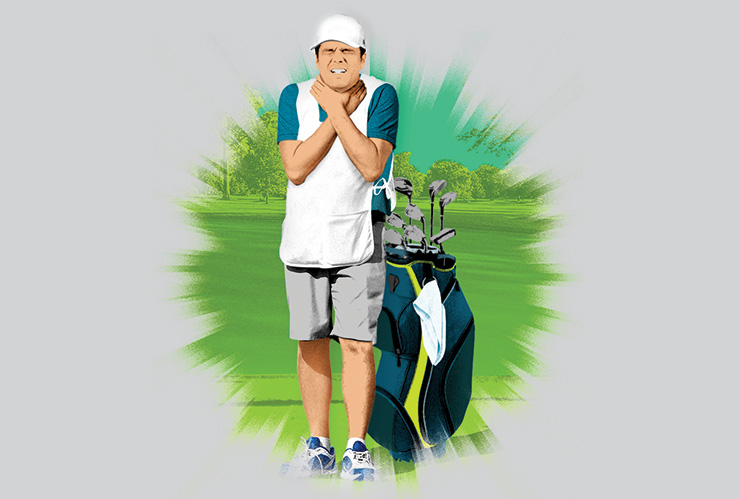Illustration by John Ritter
With Joel Beall
I have nightmares about it. The scenarios change—start of the tournament, an early Saturday tee time, as we’re walking down the 18th fairway with a five-shot lead—but the story doesn’t: I find a 15th club in the bag. I consider myself a stand-up guy, but I never do the right thing in the dream. I keep the discovery to myself, tomahawk the club into the woods, once even snapped it in two and tried to flush it down a Porta-John. I wake up petrified and disappointed in myself, and the dream keeps happening.
For the record, my guy has never had 15 clubs in his bag. So yeah, you better believe we’re terrified of making mistakes.
They happen. Don’t care if you’ve been out here for two months or 20 years, everyone has a story of slipping up, and—as my night terrors prove—we all live in fear of the next miscue.
The blunders are not as public as caddie Myles Byrne discovering 15 clubs in the bag for Ian Woosnam at the 2001 Open or Bandon Dunes looper Brant Brewer touching the sand on the 18th hole to lose the hole, and match, for Oliva Pinto at this summer’s U.S. Amateur. Sometimes they’re the simplest of things, like oversleeping a tee time or leaving the raingear out of the bag, only for the heavens to open up. That doesn’t make them easier swallows.
Giving yardages sounds simple. Is simple. But when you’re giving them out 18-plus times a day, four times a week, 30 weeks of the year, you’re going to give a wrong number. Maybe you walked three yards off but added three, or read the distance to the middle instead of a back-tucked pin. For these guys, a wrong number by three yards makes all the difference. Done it three times in the past 15 or so years. First time, my player came up 10 yards short of the green. I realised what happened and told him. Had to. To his credit, he took it in stride. Maybe too in stride, as he joked to his playing partner about his “mystery” number. “Oh, yeah?” said his opponent, a Hall of Famer. “Any more ‘mysteries,’ and it won’t be a mystery why he’s out of a job.” Oof.
The second time was a practice round about five years later, same guy. Should have been 180 yards; told him 188. If I would have looked up from my book, it was clearly 180, and he knew it. But he said nothing and hit his ball well over. As soon as the ball’s in the air, he turns to me and yells, “Start doing your job!” Man, did that sting. But you have to own it. It’s your fault.
Undercover Caddie: Do tour pros cheat? Here’s your answer
Then there are the complex mistakes, and the majority of the time they happen when you’re in a pressure situation. What can I say? Just like players, we sometimes stumble in the clutch.
The first is giving the wrong club. First round, you usually let your guy feel his way out, talking him out or into a different stick only if it’s egregious. When you’re on the cut line or in contention, you tend to assert yourself more on those in-betweeners. By the way, this is not a wrong-yardage thing. It’s part strategy, part knowing the effect adrenaline and pressure and stress are going to have on your guy. Two examples: Last year I got my guy into a club lower at TPC Sawgrass’ island-green 17th because I knew with the blood flowing he was going to hit anything a few yards farther. That time it worked—he hit it to 10 feet and made his bird. But this season on a drivable par 4, I got him into a 3-wood because I thought the driver brought too much trouble into play. I didn’t read the situation right, because that affected his confidence. He still found the trouble.
Most of the time we’re right when suggesting another club. When we’re wrong, it can be bad. And there’s a chance your guy goes sideways the next hole because he’s thinking how you just screwed him.
Caddie Confidential: Helen Storey takes us inside the ropes with Lee Westwood
Another way caddies mess up with the tournament on the line is being timid. You want to stay out of your player’s way and let him focus on the course, but if you’re not talking as much or acting differently—trust me, they notice—they take it as doubt or fear. But the biggest way we fail when it matters most is . . . positivity.
It’s human nature: You want to keep your guy in an upbeat, bullish mood. Everyone wants to deliver the pump-up speech, but if your guy is good, he’s going to be in contention a number of times. Do the rah-rah thing in each of those instances, it loses its effect when you really need it. And golf isn’t football or basketball, where we need to get amped up. We’re (mostly) trying to keep calm. Besides—and a former player told me this, which I pass on to all new caddies—it’s OK to let a player be mad. You tell him it’s fine after he makes bogey, and it might just piss him off more. Nothing wrong with letting him stew; he’s about to get an extra 10 yards off that next drive because of it.
Just make sure on the first tee it’s the only driver in his bag. Sorry, that was the nightmare talking.









